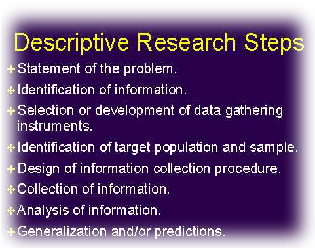Descriptive Research
A diverse staff of 17 senior scientists and a growing interdisciplinary team of more than
180 researchers, technicians, and students conduct long-term descriptive and experimental research that cuts across traditional disciplinary boundaries. Studies range from the effects of nutrients and chemicals passing through our landscapes to maintenance of productive fisheries, changes to our environment from biological invaders, BSSRO-INDIA .
A descriptive study is one in which information is collected without changing the environment (i.e., nothing is manipulated). Sometimes these are referred to as “ correlational ” or “ observational ” studies. The Office of BSSRO defines a descriptive study as “Any study that is not truly experimental.” In human research, a descriptive study can provide information about the naturally occurring health status, behaviour, attitudes or other characteristics of a particular group. Descriptive studies are also conducted to demonstrate associations or relationships between things in the world around you.
Descriptive studies can involve a one-time interaction with groups of people ( cross-sectional study ) or a study might follow individuals over time ( longitudinal study ).
Descriptive studies in which the researcher does not interact with the participant include observational studies of people in an environment and studies involving data collection using existing records (e.g., medical record review).Descriptive studies, in which the researcher interacts with the participant, may involve surveys or interviews to collect the necessary information.


As the name implies, descriptive research methods are used when the researcher wants to describe specific behaviour as it occurs in the environment. There are a variety of descriptive research methods available, and once again, the nature of the question that needs to be answered drives which method is used. Traditionally, descriptive research involves three main categories: observation, case studies, and surveys. Let's take a closer look at each of these individually.
Observational research involves, well, observing. Say for instance you were interested in learning more about how toddlers from different cultures engage in play activities. You would not want to impact their natural inclinations to behave and engage in play activity, so you would watch from afar or perhaps through a two-way mirror,
simply observing and noting what you are seeing.After you complete all of your observations, you can then make inferences about the differences and similarities that were noted. Nothing has been manipulated and hopefully they didn't even know you were there.
Case Study
Another type of descriptive research method is called a case study. A case study involves making detailed observations about one specific case. For instance, a medical student who is interested in learning more about a particularly unique patient might study the behaviours and thought processes of that one individual. This could consist of observations or interviews, but like observational research, there is no influence from the researcher. The intent is simply to examine closely the qualities and characteristics f of this one case.
Case example of a descriptive study
Descriptive studies are usually the best methods for collecting information that will demonstrate relationships and describe the world as it exists. These types of studies are often done before an experiment to know what specific things to manipulate and include in an experiment.
In this lesson you will learn to define descriptive research as well as to identify the three main types of descriptive research used in the field of psychology. Following this lesson you will have the opportunity to test your knowledge with a short quiz.
We also recommend watching Descriptive Research Design: Definition, Examples & Types andWithin-Subject Designs: Definition, Types & Examples